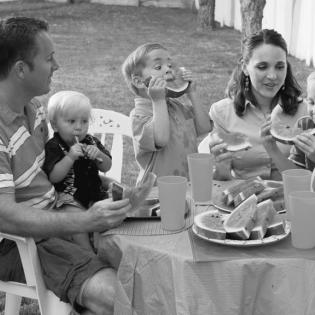Healthy Food Choices - Are they Needs or Wants?
Students learn about food choices as needs or wants. They read a book and discuss healthy choices. They discuss why is not always good to have everything you want. They discuss the foods we need to have healthy bodies and minds. Students create healthy food choice plates and share them to encourage healthy eating. Students may choose to share a healthy recipe to donate a cookbook or host a healthy food or recipe drive.
Learners will:
- define vocabulary related to choices through discussion and the reading of the book, Gregory, The Terrible Eater.
- identify healthy food choices as needs and unhealthy food choices as wants.
- read-aloud copy of Gregory the Terrible Eater by Mitchell Sharmat
- chart paper
- markers
- paper plates
- crayons
- wants: something you would like to have
- needs: things you need to survive
- choice: a decision between two or more options
- generosity: sharing freely; abundant; overflowing
Have students draw what they ate for dinner on a T-chart worksheet (divided by healthy/need and unhealthy/want) and have them share their drawing with a partner or the whole class the next day at school.
Instructions
Anticipatory Set:
Introduce the vocabulary words: choice, needs and wants.
- wants: something you would like to have
- needs: things you need to survive
- choice: a decision between two or more options
- generosity: sharing freely; abundant; overflowing
Read the book Gregory, the Terrible Eater by Mitchell Sharmat
Gregory is a goat who loves fruits, vegetables, eggs and fish, rather than typical goat fare of tires, cans, and t-shirts. Kids will find it hilarious that Gregory’s parents don’t want him to eat his fruits and veggies and instead want him to eat trash. Instead of being told what’s healthy, the kids will be pointing it out themselves in this book of silly role reversals.
Reflect on the reading by asking the students to brainstorm Gregory's healthy and unhealthy choices using a T-chart.
- Be sure to correlate healthy food to what people need to survive and unhealthy food to the word wants.
Now ask the students to brainstorm healthy and unhealthy food choices for humans and record on a new T-chart.
Discuss what are the foods we NEED to have healthy bodies and minds. Listen to what they have learned from experience about what foods help them and what foods are not helpful. Discuss nutrients and what they do for us. Discuss why it is important to eat fewer unhealthy choices, even though they may want to eat junk food.
Thinking about a healthy community we all belong to, discuss what we can do to be generous with others about our knowledge.
Have students refer to the brainstormed T-chart about healthy foods for humans as they draw a lunch plate to teach others about making choices to eat healthy foods -- just enough to fill a need, but not too much. Students must include three healthy food choices they would like to eat for lunch. Students may also choose one want, or unhealthy choice (teaching moderation). Variation: glue magazine pictures of foods on the plates.
Have students share their plates with the class. Make sure that you correlate healthy with need and unhealthy with want. Remind students that this is just one of the many choices we must make during a day.
Hang students' lunch plates around the room or hallway as a reminder to anyone who sees them of the healthy food choices. Make a header for the display that says "We need healthy foods to have healthy bodies and minds."
- Explain to students that by sharing their plates, they are helping others think about good choices.
- Have the students make a meal plan for breakfast, lunch, and dinner using healthy/need food choices.
- Have the students cut pictures out of magazines or cut and paste on a google document healthy/need food choices.
- Introduce vocabulary words: producer and consumer. Brainstorm or research different companies that produce different healthy/need and unhealthy/want foods. Have students write how their families consume different healthy/unhealthy foods from these companies.
Service-Learning Ideas
- Students may ask a local food bank what their healthy food needs are. They can organize a healthy food drive at the school.
- Students may ask their family members for recipes of their favorite healthy foods to share.
- Recipes may be compiled into a healthy cookbook.
- Include inexpensive healthy shopping and cooking tips in the cookbook. Donate the cookbook where there is a need. (Ask the students to propose ideas and ask around.)
Differentiation
- Higher Learners: Have students draw a daily meal plan that uses too many unhealthy food choices and write a paragraph about how this diet makes them feel.
- Struggling Students: Teacher will work with each student one-on-one for support.
Ask each student to share a healthy (need) food choice orally the next day.
The handouts here are evaluations that may be completed by parents and families, community partners, students, and teachers. These evaluations may be used in conjunction with any Learning to Give lesson, toolkit, or resource. The goal is to help you collect information about the impact of your philanthropy and service-learning instruction.
Philanthropy Framework
-
Strand PHIL.I Definitions of Philanthropy
-
Standard DP 01. Define Philanthropy
-
Benchmark E.3 Recognize that citizens have a responsibility for the common good as defined by democratic principles.
-
-
